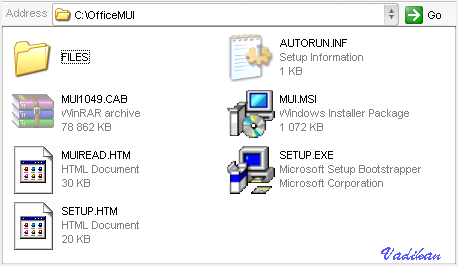Microsoft developed the MS Office 2003 to work as an office suite for the Windows operating system which is a unique product with the amazing features that have people still glued to it despite the upgrade and development of other office suites. It is known to be the only office product with the menu interfaces and a toolbar on its major applications.
Multilingual User Interface (MUI) is the name of a Microsoft technology for Microsoft Windows, Microsoft Office and other applications that allows for the installation of multiple interface languages on a single system. On a system with MUI, each user would be able to select their own preferred display language. MUI technology was introduced with Windows 2000 and has been used in every release since (up to Windows 10). The MUI technology is covered by an international patent titled 'Multilingual User Interface for an Operating System'.[1] The inventors are Bjorn C. Rettig, Edward S. Miller, Gregory Wilson, and Shan Xu.
Functionally, MUI packs for a certain product perform the same task as localized versions of those product, but with some key technical differences. While both localized versions of software and MUI versions display menus and dialogs in the targeted language, only localized versions have translated file and folder names. A localized version of Windows translates the base operating system, as well as all included programs, including file and folder names, objects names, strings in registry, and any other internal strings used by Windows into a particular language. Localized versions of Windows support upgrading from a previous localized version and user interface resources are completely localized, which is not the case for MUI versions of a product. MUI versions of a product do not contain translated administrative functions such as registry entries and items in Microsoft Management Console. The advantage of using MUIs over localized versions is each user on a computer could use a different language MUI without requiring different versions of software installed and dealing with the conflicts that could arise as a result. For example, using MUI technology, any version of Windows can host Windows applications in any other language.[2]
Gmv general mesh viewer reviews. GMV is an easy to use, 3-D scientific visualization tool designed to view simulation data from any type of structured or unstructured mesh. The following links will aide you in your search for GMV related information. The file name is 'linux64ogl' rename it to 'gmv'. Linux 64-bit Batch version The Linux Batch version has been statically linked with the Mesa library. This version uses Mesa's OSMesa buffers to generate an off-screen image and save it to an SGI RGB file. The file name is 'linux64Batch' rename it to 'gmvBatch'. Linux version with Mesa OpenGL to. GMV (General Mesh Viewer) is an easy to use, 3-D scientific visualization tool designed to view simulation data from any type of structured of unstructured mesh.
MUI in Windows 2000 and Windows XP[edit]
MUI products for these versions were available only through volume agreements from Microsoft. They were not available through retail channels. However, some OEMs distributed the product. Up to Windows XP, MUI packs for a product are applied on top of an English version to provide a localized user experience.
MUI in Windows Vista and Windows 7[edit]
Windows Vista further advanced MUI technology with support for single, language-neutral, language-independent binary files supporting multiple language skins, with the language-specific resources contained in separate binaries. The MUI architecture separates the language resources for the user interface from the binary code of the operating system. This separation makes it possible to change languages completely without changing the core binaries of Windows Vista, or to have multiple languages installed on the same computer while using the same core binaries. Languages are applied as language packs containing the resources required to localize part of or the entire user interface in Windows Vista.
MUI packs are available to Windows Vista Enterprise users and as an Ultimate Extra to Windows Vista Ultimate users. MUI packs are also available to Windows 7 Enterprise and Ultimate edition users.
Beginning with Windows Vista, the set of associated MUI APIs are also made available to developers for application development.
Beginning with Windows 7, Microsoft started referring to MUIs as 'Language Packs,' although this isn't to be confused with Language Interface Packs (LIP)[3]
How to install reunion patch ff7 characters. Go your FF7 install directory and rename the 'FF7en.exe' (ex: 'FF7ensteam.exe') This is important as this is the original steam exe, if this is present Reunion will patch this instead of the converted FF7.exe.
MUI in Windows 8/8.1/RT and Windows 10[edit]

Beginning with Windows 8/RT, all editions of Windows are able to download and install all Language Packs.[4]

See also[edit]
- Language Interface Pack (LIP)
References[edit]
- ^US patent 6252589, 'Multilingual user interface for an operating system', published 2003-05-14
- ^'Guide to Windows Vista Multilingual User Interface'. Microsoft. Retrieved 24 Feb 2014.
- ^'How To Install Language Packs In Windows 7'. The Windows Club. Retrieved 29 Apr 2016.
- ^'Language packs are available for Windows 8 and Windows RT'. Microsoft. Retrieved 29 Apr 2016.
External links[edit]
- Windows MUI Knowledge Center[permanent dead link]